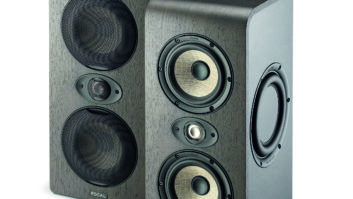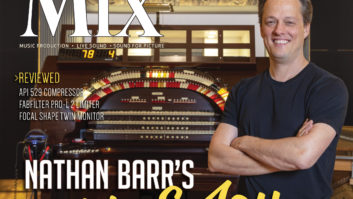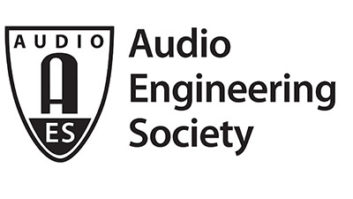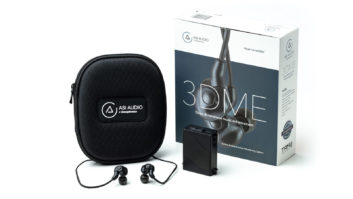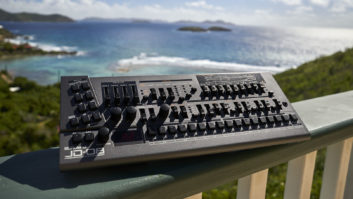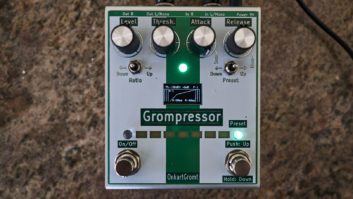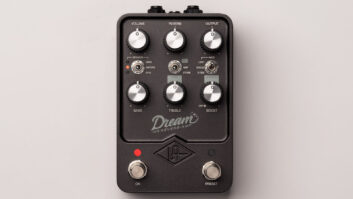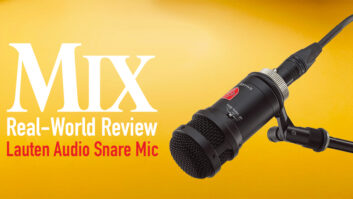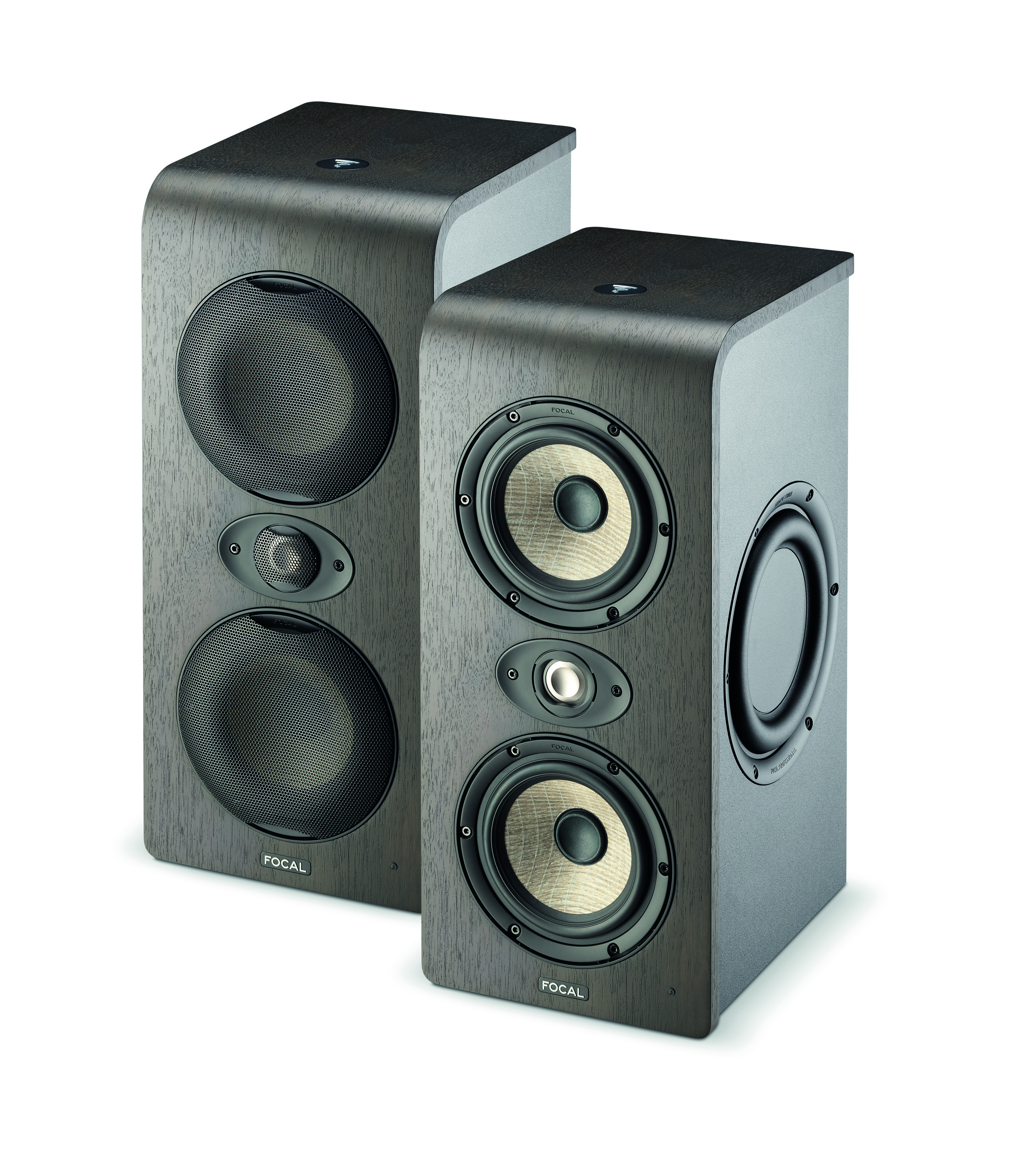
Focal introduced its Shape series of self-powered nearfield studio monitors in 2017 with three models—the Shape 40, 50 and 65—all featuring newly designed drivers and tweeters, passive radiators, and a few other signatures. The series is aimed particularly at users who work in small listening rooms, such as home studios, and offers features designed to minimize acoustic issues.
At NAMM in January 2018, Focal unveiled the Shape Twin, the new flagship of the line. It builds on the features of the original Shape models, while adding some new wrinkles.
The Shape Twin’s MDF cabinet has a nice-looking walnut veneer and is slightly curved on top. True to its mission to be small-studio friendly, it has a slim profile (18.8 x 8.3 x 11 inches).
It contains two vertically oriented 5-inch drivers with a tweeter sandwiched in between. The company labels it a tri-amplified, “2.5”-way system, with the drivers each powered by an 80-watt Class AB amp and the tweeter by a 50-watt version. Focal included a mounting point on the rear and small feet on the bottom called Decoupling Spikes. The latter also allow you to adjust the listening angle.
Each spike is threaded and has an adjustment ring that you turn to unscrew and lengthen it. Lengthening is easy. Shortening is a little awkward—you have to hold the adjustment ring against the top part of the spike to make it turn when you’re shortening it. Not a big deal.
Fractional Behavior
The unique part of the design, and what makes it a 2.5-way system instead of a 3-way, is that one of the drivers handles frequencies from 40 Hz to 180 Hz and the other from 40 Hz to 2.5 kHz. One is bass and midrange, the other just bass. According to Focal, this configuration gives the Shape Twin essentially the same woofer surface area as a standard 8-inch monitor, which accounts for its bass response going down to 40 Hz.
Review: Focal SM9 Studio Monitors, by Kevin Becka, Oct. 1, 2012
Like the other Shape Series speakers, the driver cones are made of a combination of flax and glass fibers. The tweeter, also introduced with the Shape Series, is an inverted “M”-shaped dome tweeter, which has lower directivity than other designs (making the sweet spot wider for the listener) and is rigid and less prone to distortion.
The Shape Twin isn’t ported but instead has an 8-inch passive radiator on each side of the cabinet. The radiators are connected by U-shaped suspensions that help eliminate rocking modes that can create low-frequency problems. Focal says these features allow the Shape Twin to be positioned close to walls without the bass issues that can plague ported monitors.
The Shape Twins come with metal mesh covers for the drivers and the tweeters, but I would imagine most people will leave those off.
On the back of each speaker, you’ll find XLR and RCA inputs and a power switch. An automatic function keeps the amplifiers in Standby mode after the power switch has been turned on until the inputs receive an audio signal. The speakers also go into Standby mode after they’ve received no audio for 30 minutes. The green power-on LED on the front turns red when in Standby, and back to green when it’s off.
The Standby feature is useful for saving energy and makes it possible to leave the power on for long periods of time without using too much juice. It does take the Shape Twins a second or so to ramp up from Standby, and so the first bit of audio gets cut off. I would prefer if the Standby feature could be switched off if need be, but I understand that there are energy conservation regulations appearing around the globe, with Europe taking the lead. So again, not a big deal.
The rear of the Shape Twin also sports a series of controls to allow tailoring the units to particular room acoustics. The LF Shelving knobs boost or attenuate frequencies under 250 Hz. The LMF adjustment is a bell-shaped filter centered at 160 Hz that Focal recommends using at -1, -2 or -3 dB if you’re placing the monitors on tables or console bridges or other surfaces that cause reflections. The HF Shelving control governs frequencies above 4.5 kHz and can be used to tame a bright room or add brightness to a dead room.
The frequency controls are handy, but I wish that they were detented. It always bothers me when monitors have non-detented adjustment knobs (whether for frequency or volume), as it is impossible to know whether you’ve set both sides equally.
The final knob, which is detented, is a highpass filter with a 12 dB-per-octave slope. Its primary purpose is to roll off low end when a subwoofer is being used in the system. However, Focal also suggests using it for rooms that are bass-heavy.
The Shape of Sound
The Shape Twins require a 10-hour burn-in period, in which you have the keep the volume relatively low. After that, you can turn them as loud as you need to, and they’re plenty powerful.
I’ve had a pair of Shape Twins in my studio for a couple of months now while working on this review. I’ve used them for mixing and tracking a variety of material ranging from rootsy acoustic music to rock mixes with full bands including drums. I’ve been extremely impressed with the detail they deliver. The reproduction of transients is excellent; from the pick scraping the strings on an acoustic guitar to the crack of a drumstick whacking a snare or tom.
Review: Focal Trio6 Be Monitors, by Kevin Becka, May 30, 2016
In my testing, they accurately reproduced everything from thick and crunchy electric guitars to the chime-y tones of a banjo to the midrange-y sweetness of a dobro to the thump of an upright bass. Their imaging is excellent, and the 2.5-way configuration gives them wide-ranging frequency coverage from low to high, with smooth crossover points and no holes in the midrange.
The bass response is also solid, especially considering the driver size. Although Focal says that the 2.5-way configuration is equal in surface area to an 8-inch driver, it didn’t put out as much bass as a couple of different 8-inch monitors I put them against, namely the PreSonus R80 and Genelec 1031A.
Want more stories like this? Subscribe to our newsletter and get it delivered right to your inbox.
In addition to auditioning the Shape Twins in my studio, which is a reasonably large, untreated, irregularly shaped wooden space, I thought it would be interesting to hear what they sounded like in a treated, pro-studio control room. The good folks at nearby Sound on Sound Studios, a longtime Manhattan facility that recently relocated to nearby Montclair, N.J., were kind enough to let me do a listening test in their Studio B control room.
We set up the Shape Twins on the console bridge, next to a pair of Genelec 1031As. The Focals sounded excellent, as they had at my studio, and certainly seemed as if they belonged. We auditioned them on a wide range of music, including Steely Dan (the official music of monitor testing), hip hop and pop for the bottom end, and a variety of rock and orchestral music. In all cases, the Shape Twins were bright, clear, focused and balanced—not to mention plenty loud—and everyone at the studio who heard them was impressed.
We tried them both in the inside and outside positions on the console. In the former, they were about 3.5 feet apart, and in the latter 6 feet. I liked the way they sounded a little better in the closer position, which makes sense considering they were designed for space-challenged studios, but the differences were minor.
Review: Focal Alpha 80 Monitors, by Steve La Cerra, Nov. 3, 2015
The monitor market is a highly competitive one, even in the relatively high echelons that these Focals inhabit. When you spend $1,000 or more for each monitor, you expect highly professional results, and the Shape Twin does not disappoint.
Product Summary
Company: Focal
Product: Shape Twin
Website: www.focal.com
Price: $1,099 (each)
Pros: Excellent detail and imaging. Smooth frequency response. Big sound with a small footprint. Adjustable Decoupling Spikes. Plenty of frequency adjustment features. Auto-Standby feature makes it possible to leave monitors on for long periods without wasting energy.
Cons: Decoupling Spikes awkward to shorten. Auto Standby can’t be turned off. Except for the HPF, none of the frequency adjustment knobs are detented.
